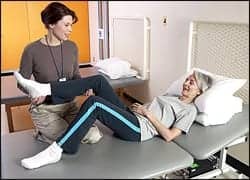 |
A sluggish economy, lagging profit margins, and rising inflation are causing reorganizations of business practices throughout the country—and the physical medicine and rehabilitation industry has not been exempt from this trend. Government-imposed therapy caps, limited reimbursements, and company mergers have encouraged most industry professionals to reevaluate how to remain fiscally secure, without sacrificing the level and quality of service offered to their clients. It is a delicate balance. Ironically, as financial concerns rise to new levels, so have the number of individuals with acute and long-term needs for the services of physical and occupational therapists, home health care workers, and product innovators. It can be a challenge to remember that the client is the most significant person in the equation.
For those in the physical medicine and rehabilitation industry, now is the time to become advocates for yourselves and your clients, and present a united front that will make an impact on political leaders and ultimately benefit all those affected by the industry.
In an effort to give back to the client (or end user) by providing state-of-the-art products and quality education, three forward-thinking mobility device manufacturers—The ROHO Group, TiLite, and Permobil—recently announced the launch of Users First Alliance, a coalition dedicated to improving the quality of life, as well as long-term physical and mental health outcomes, for clients with disabilities.
According to The ROHO Group’s executive vice president, Tom Borcherding, “The founding members of the Users First Alliance believe that consumers and clinicians should expect more than equipment that is considered ‘just good enough.’ ” Users First Alliance also intends to provide information to educate users, clinicians, and providers on reimbursement and coding decisions, as well as recognizing their clients’ needs and selecting the appropriate equipment to meet those needs.
|
To find out more about Users First Alliance, go to www.usersfirst.org. |
|
In addition to the creation of this advocacy group, compassionate and insightful innovators are developing new and improved products for the rehabilitation marketplace, including mobility aids, communication devices, pain-management solutions, treatment modalities, and therapeutic tools.
In an effort to assist rehabilitation industry professionals with the purchasing decisions they will need to make to empower their practices throughout the year, Rehab Management’s 2007 Buyer’s Guide provides a comprehensive, easy-to-use reference source of those tools and resources. The guide includes company information, product categories, and trade name references—presented in alphabetical format for your convenience.
—Rogena Schuyler Silverman



